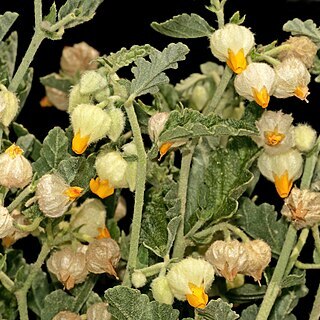Erect suffrutex, with woody taproot, several stemmed, branching from base, 0.1-1.1 m high; pubescent to tomentose with fine, short, appressed stellate hairs, intermixed with stipitate, stellate hairs. Leaves basally arranged, long petiolate, ovate to oblong-ovate; cauline leaves smaller; tomentose as above. Stipules ± linear-lanceolate. Inflorescences terminal or axillary, 2-flowered cymes; peduncles 5-20 mm long; pedicels tomentose. Flowers ± 12 mm long, yellow-orange. Calyx inflated, globose, narrowed at mouth, ivory-coloured, 5-lobed almost to middle; pubescence of short, stellate hairs intermixed with stipitate, tufted hairs. Petals upper 1/3 oblong-orbicular, narrowed into claw. Flowering time all year. Fruit a capsule enclosed in persistent calyx.
Perennial herb, up to 0.2 m high. Leaves with long petioles; blade oblong to oblong-obovate, pubescent with fine stellate hairs on both surfaces, but more often densely tomentose on lower surface. Flowers: usually in 2-flowered cymes, 2 or 3 developing at apices of branches and in axils of upper leaves; bracts with margins entire; calyx inflated, narrowed at mouth; petals 10 mm long, lemon-yellow; Oct.-Jan.
Perennial herb, up to 200 mm tall. Leaves long-petioled, blade oblong to oblong-obovate, 15-50 x 6-35 mm, pubescent with fine stellate hairs on both surfaces, but more often densely so to tomentose underneath. Inflorescence: usually 2-flowered cymes, 2 or 3 developing at apices of branches and in axils of upper leaves. Calyx inflated, narrowed at mouth. Petals 10 mm long. Flowers lemon-yellow.
Leaf-lamina c. 3 × 2 cm., ovate-oblong, apex acute, base broadly cuneate, margin irregularly serrate, crenate or undulate, tomentose on both sides, ± discolorous, appearing ± plicate due to nerves being ± deeply immersed above and raised below; petiole up to c. 3 cm. long, tomentose; stipules up to 5 mm. long, subulate, tomentose.
Like H. johanssenii but leaves, especially the lower, long-petioled and flowers not clearly turned to one side in leaf axils, but 2 or 3 at tips of branches and in axils of upper leaves, and calyx whitish cream, often suffused with green, yellow or pink and with stalked tufted hairs.
Flowers in pairs in the axils of the upper leaves; peduncles c. 1–1·5 cm. long, tomentose; pedicels up to 5 mm. long, tomentose; bracts and bracteoles 2–5 mm. long, subulate, tomentose.
Calyx up to c. 1 cm. in diam., inflated, globose-campanulate, toothed about 1/5–1/3 of the way down, tomentose, often with stalked stellate hairs or appendages on the angles.
Petals yellow, slightly exceeding the calyx, spathulate with the margins infolded in the lower half, stellate-pubescent on both sides.
Ovary subglobose, shortly stipitate, apex truncate with 5 blunt processes, tomentose; styles 5 mm. long, puberulous near the base.
Stamens with narrowly obovate filaments c. 4 mm. long and pubescent on the shoulders; anthers c. 4 mm. long, pubescent.
Perennial herb c. 20 cm. tall; branches densely stellate-tomentose.
Ripe capsules not seen.

